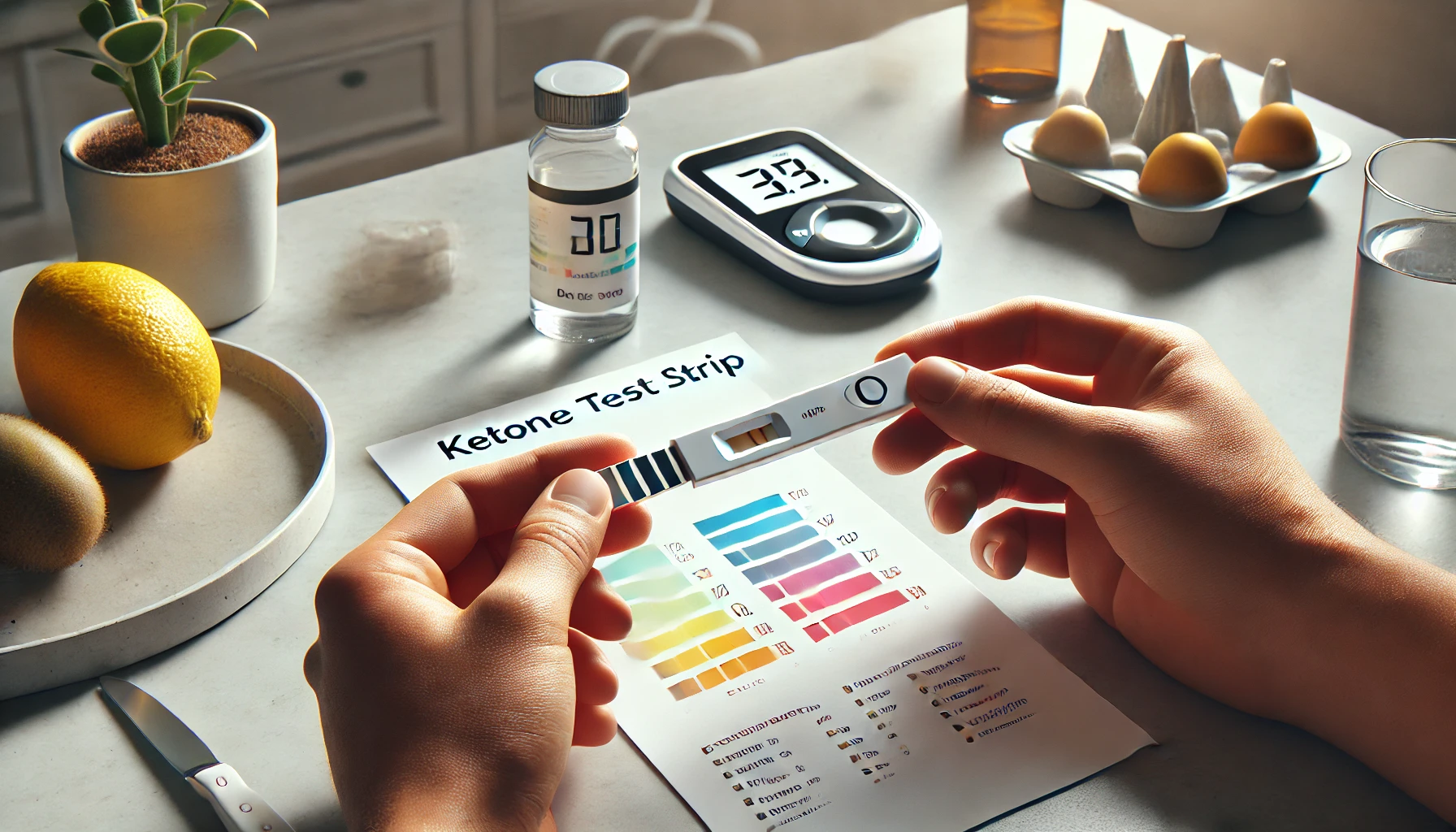Health News
blood ketone meter, diabetic ketoacidosis, keto diet tools, keto weight loss, ketogenic diet, ketogenic monitoring, ketone, ketone levels, ketone test, ketone test strips, ketone urine strips, ketosis, ketosis health benefits, ketosis test, ketosis vs DKA, measuring ketones, urine ketone testing, weight loss
Best Ketone Test Strips: Understanding Ketosis and How to Measure Ketones Effectively
Achieving ketosis, where your body shifts from burning carbohydrates to burning fat for energy, is one of the primary goals of following a ketogenic diet. Whether you’re aiming for weight loss, enhanced mental clarity, or improved energy levels, being in ketosis can help you meet your health and fitness goals. Monitoring your body’s ketone levels using ketone test strips is an easy and effective way to ensure you’re in this fat-burning state and making necessary adjustments to your diet.
However, it’s essential to understand that elevated ketones are not always beneficial, especially for individuals with diabetes. In people with uncontrolled diabetes, high ketone levels can signal diabetic ketoacidosis (DKA), a life-threatening condition. This blog will guide you through how ketone strips work, how to interpret the results, and the best options for monitoring ketosis and avoiding complications like DKA.
What is Ketosis?
Ketosis is a natural metabolic state where your body shifts from using carbohydrates to burning fat for energy. When you follow a low-carb ketogenic diet, your intake of carbohydrates is drastically reduced, causing your body to deplete its glycogen stores. In response, your liver begins converting fatty acids into ketones, which serve as an alternative fuel source for your brain and body.
Achieving ketosis can help with:
- Weight loss: By burning fat for fuel.
- Mental clarity: Many people report sharper focus when in ketosis.
- Steady energy levels: Unlike carbs, which can cause energy spikes and crashes, ketones provide a more stable source of fuel.
While ketosis is a desirable state for those following a ketogenic diet, it’s crucial to differentiate it from diabetic ketoacidosis (DKA), which occurs when ketone levels become dangerously high due to a lack of insulin.
The Importance of Measuring Ketones
To make sure you’re in ketosis, monitoring your ketone levels is key. There are three types of ketones your body produces:
- Acetoacetate: Measured in urine.
- Acetone: Detected through breath.
- Beta-hydroxybutyrate: Measured in the blood.
The easiest and most common way to check for ketosis is by using urine test strips that detect acetoacetate levels. However, for more accurate results, blood ketone meters and breath analyzers can also be used. Each method has its pros and cons, but understanding how to measure and interpret ketones is essential for those on a ketogenic diet and for people with diabetes who need to avoid DKA.
Ketone Test Strips: A Simple Way to Check for Ketosis
Ketone test strips are a simple and inexpensive tool to measure your ketone levels. These strips detect acetoacetate in urine, which turns the test strip different shades of pink or purple depending on the concentration of ketones. The darker the color, the higher your ketone levels.
To use ketone strips, follow these steps:
- Collect a urine sample: Use a clean container to collect your urine.
- Dip the strip: Insert the strip into the urine sample and remove it immediately.
- Wait for results: After 15-30 seconds, the strip will change color. Compare the color to the chart provided on the packaging to determine your ketone level.
While urine strips are convenient, they are not as precise as blood or breath testing. Blood ketone meters offer the most accurate readings by measuring beta-hydroxybutyrate directly from a blood sample, similar to a glucose meter. Breath analyzers are non-invasive and measure acetone in the breath, offering a more comfortable way to monitor ketosis.
What Ketone Levels Mean
Understanding your ketone levels is vital for assessing your metabolic state. Here’s a breakdown of ketone levels and what they indicate:
- Negative (no ketones): Not in ketosis.
- Trace (0.5 mmol/L): Mild nutritional ketosis.
- Small (1.5 mmol/L): Light nutritional ketosis.
- Moderate (4.0 mmol/L): Higher ketones, often due to exercise or fasting.
- Large (8.0 mmol/L): Generally from extended fasting; not sustainable.
- Larger (16 mmol/L): Excessively high, usually seen after prolonged fasting.
For people following a well-formulated ketogenic diet, ketone levels between 0.5 mmol/L and 2.0 mmol/L are typical. Higher levels, especially those above 4.0 mmol/L, should be approached with caution, particularly in individuals with diabetes, as they may indicate DKA.
Ketosis vs. Diabetic Ketoacidosis (DKA)
While ketosis itself is a harmless and often beneficial state for those on a ketogenic diet, diabetic ketoacidosis (DKA) is a medical emergency. DKA occurs when ketone levels become dangerously high, usually due to a lack of insulin, causing the blood to become acidic. This condition can lead to dehydration, coma, and even death if left untreated.
People with type 1 diabetes or uncontrolled type 2 diabetes are at a higher risk of developing DKA, especially if they are not monitoring their insulin levels properly. Symptoms of DKA include:
- Excessive thirst.
- Frequent urination.
- Nausea and vomiting.
- Abdominal pain.
- Confusion or difficulty concentrating.
If you suspect DKA, seek immediate medical attention.
Choosing the Best Ketone Strips and Testing Methods
When deciding how to monitor your ketone levels, consider the following testing options:
- Urine Ketone Strips
- Pros: Inexpensive, easy to use, and widely available.
- Cons: Less accurate, especially as your body adapts to ketosis.
- Blood Ketone Meters
- Pros: Highly accurate, measures beta-hydroxybutyrate, the primary ketone.
- Cons: Requires a finger prick and blood sample, more expensive.
- Breath Ketone Analyzers
- Pros: Non-invasive, no need for strips or blood samples.
- Cons: Less precise than blood meters, higher upfront cost.
Maintaining Safe Ketone Levels
While achieving ketosis is a primary goal for many following a ketogenic diet, maintaining safe ketone levels is crucial, particularly for people with diabetes. Here are a few tips to ensure you stay in the healthy range:
- Monitor regularly: Use ketone strips or a blood ketone meter to check your levels, especially during the early stages of ketosis.
- Stay hydrated: Drink plenty of water to help flush excess ketones from your system.
- Avoid extended fasting: Prolonged fasting can raise ketone levels too high, leading to potential health risks.
- Work with a healthcare provider: If you have diabetes, consult your doctor to manage your ketone levels and prevent complications like DKA.
Conclusion
Monitoring your ketone levels is an essential part of following a ketogenic diet or managing diabetes. By using tools like ketone test strips, blood ketone meters, or breath analyzers, you can track your progress and stay within a safe range. While ketosis offers many benefits, it’s crucial to avoid diabetic ketoacidosis by keeping an eye on your ketone levels and ensuring you don’t exceed the recommended range.
Whether you’re using urine strips for convenience or opting for the accuracy of a blood ketone meter, monitoring your ketones is a key step in reaching your health and fitness goals.



